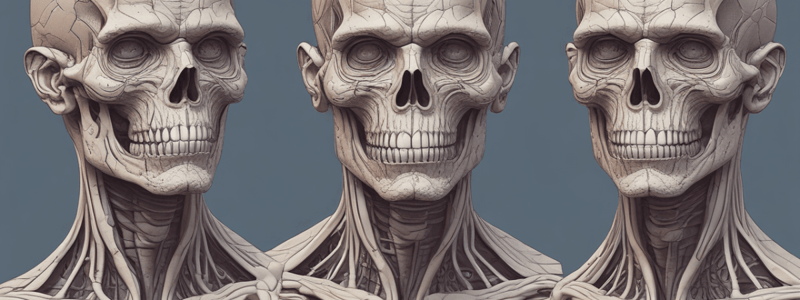Podcast
Questions and Answers
What is the basis of the automatic speech recognition (ASR) process used for generating closed captions?
What is the basis of the automatic speech recognition (ASR) process used for generating closed captions?
- Machine learning algorithms (correct)
- Video content analysis
- Audio quality assessment
- Human transcription
What is the approximate accuracy of the ASR process for generating closed captions?
What is the approximate accuracy of the ASR process for generating closed captions?
- 50-70%
- 90-100%
- 100%
- 70-90% (correct)
What is the most accurate reflection of the content in video and audio materials?
What is the most accurate reflection of the content in video and audio materials?
- The captions
- The original recording (correct)
- The transcript
- The summary
What is the fundamental building block of the whole body?
What is the fundamental building block of the whole body?
What is linked to genetics, homeostasis, and endocrinology in the context of human development?
What is linked to genetics, homeostasis, and endocrinology in the context of human development?
What is essential to understand for pathophysiologies and psychopathophysiologies?
What is essential to understand for pathophysiologies and psychopathophysiologies?
What is the portion of the genome that encodes proteins?
What is the portion of the genome that encodes proteins?
What is the function of transfer RNA (tRNA)?
What is the function of transfer RNA (tRNA)?
What is the result of protein synthesis?
What is the result of protein synthesis?
What is the sequence of three nucleotides that corresponds to an amino acid in the genetic code?
What is the sequence of three nucleotides that corresponds to an amino acid in the genetic code?
What is the process of creating an exact replica of a DNA molecule?
What is the process of creating an exact replica of a DNA molecule?
What is the function of the ribosome in protein synthesis?
What is the function of the ribosome in protein synthesis?
What is the complete set of genetic instructions for an organism?
What is the complete set of genetic instructions for an organism?
What is the result of incorrect protein folding?
What is the result of incorrect protein folding?
What is the purpose of the enzyme RNA polymerase?
What is the purpose of the enzyme RNA polymerase?
What is the sequence of nucleotides on the tRNA that is complementary to the codon on the mRNA?
What is the sequence of nucleotides on the tRNA that is complementary to the codon on the mRNA?
Flashcards are hidden until you start studying
Study Notes
Captioning Statement
- Closed captions in University videos and audio content are generated by automatic speech recognition (ASR) with approximately 70-90% accuracy.
- Accurate captions can be requested from the Inclusion Centre as part of reasonable adjustments.
DNA and Protein Synthesis
- DNA (Deoxyribonucleic Acid) contains genetic code for synthesizing proteins, which are crucial for cellular functions.
- A gene is a portion of DNA that carries genetic information for making a single protein.
- The complete set of genetic instructions for an organism is called the genome, and the portion that encodes proteins is called the exome.
DNA Structure
- DNA molecules consist of nucleotides, which form sugar-phosphate backbones with bases (adenine, guanine, cytosine, and thymine) that pair in a complementary manner.
- The double helix structure of DNA is maintained by weak hydrogen bonds between the base pairs.
DNA Replication
- During interphase, DNA replication occurs, and the double helix unwinds, allowing DNA polymerase to bring new nucleotides to each strand.
- Each new DNA molecule consists of one parental strand and one newly-synthesized strand.
Protein Synthesis
- Protein synthesis requires two sequential steps: transcription and translation.
- During transcription, RNA polymerase directs the synthesis of messenger RNA (mRNA) in the nucleus, according to the rules of complementary base pairing.
Transcription
- mRNA molecules are single-stranded, contain ribose instead of deoxyribose, and have uracil instead of thymine.
- RNA polymerase recognizes the beginning and end of a gene and copies the DNA template strand.
Comparison of DNA and RNA
- DNA is double-stranded, found in chromosomes, and contains the genetic information for protein synthesis.
- RNA is single-stranded, found in the cytoplasm, and carries transcribed DNA information for protein synthesis.
Translation
- During translation, mRNA moves out of the nucleus and associates with a ribosome, where the protein is constructed.
- Transfer RNA (tRNA) carries amino acids to the ribosome, and the anticodon matches the codon on the mRNA.
- The ribosome holds the mRNA in position, and the tRNA carries the correct amino acid in sequence, with anticodons matching up to codons.
Codons and Protein Synthesis
- Codons are three-base sequences of DNA nucleotides that correspond to amino acids.
- The sequence of codons determines the sequence of amino acids in a protein.
- There are 20 different types of amino acids, each with its own tRNA.
Protein Folding
- Correct protein folding is required for good health and protein function.
- Misfolded proteins are either refolded or destroyed by proteasomes.
- Gene expression is the basis for cell differentiation.
Studying That Suits You
Use AI to generate personalized quizzes and flashcards to suit your learning preferences.




